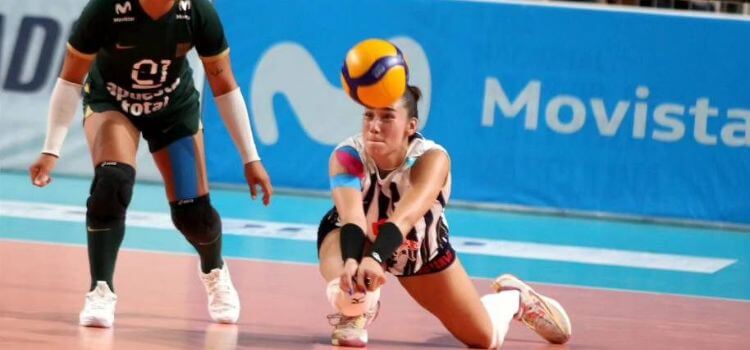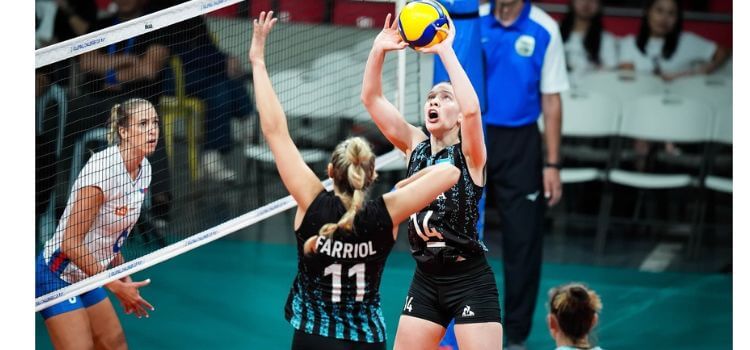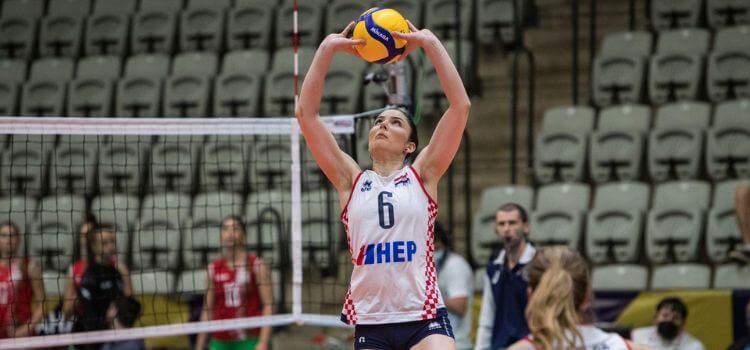As an Amazon Associate, I earn from qualifying purchases
In volleyball, a “lift” (also called a “carry” or “held ball”) is a type of illegal hit. It occurs when a player makes prolonged contact with the ball, essentially holding or carrying it, instead of making a quick, clean hit.
For example, if a player catches the ball in their hands, even momentarily, or allows the ball to rest in their palms before releasing it, this would be considered a lift. Lifts are typically called when the ball is not struck with a clean, sharp motion, such as when using open palms or when the ball visibly slows down during contact.
Definition of a Lift in Volleyball
A lift, also known as a “carry,” occurs when a player makes an illegal contact with the ball, typically involving prolonged contact or improper handling.
Basic Definition A lift is when a player’s hand remains in contact with the ball for too long, making it appear as though the ball is being carried or thrown rather than hit.
Official Rulebook Description According to the official volleyball rulebook, a lift is any action where the ball comes to rest momentarily in a player’s hands or arms. This type of contact is illegal and results in a point for the opposing team.
How a Lift Affects the Game
Impact on Gameplay When a lift is called, the opposing team gains a point and the serve. This penalty can shift the momentum of the game, making it crucial for players to avoid such errors.
Examples of Lift Calls Typical scenarios include:
A setter holding the ball too long while setting.
A player’s fingers visibly bending backward when hitting the ball, indicating prolonged contact.
Recognizing a Lift Common Signs and Movements Recognizing a lift involves looking for certain signs, such as:
The ball pausing in the player’s hands.
Unusual hand or finger movements suggesting a carry.
How Referees Identify Lifts Referees watch for prolonged contact and the ball coming to a complete stop in the player’s hands. Their decision is based on both the speed and the smoothness of the ball’s movement.
What’s The Difference Between a Lift and a Carry?
In volleyball, the terms “lift” and “carry” are often used interchangeably, as they both describe an illegal action where a player makes prolonged contact with the ball. However, there are subtle differences in how these terms are understood:
Lift: This term is generally used to describe a situation where the ball is held or rests on the player’s hands or arms, rather than being hit cleanly. It’s as if the ball is “lifted” instead of being struck quickly.
Carry: A carry typically refers to a more obvious form of prolonged contact, where the ball is caught and thrown or “carried” instead of being struck. This usually involves the player using their hands or arms in a way that catches the ball and then propels it, rather than executing a quick hit.
In essence, both a lift and a carry involve illegal prolonged contact with the ball, but a carry might be seen as more blatant or pronounced in terms of catching or throwing the ball. Both result in a point for the opposing team.
Types of Lifts in Volleyball
Hand Position Violations Improper hand positioning during a set or pass can result in a lift call. This includes using open hands to push the ball rather than hitting it.
Extended Contact Violations When a player makes extended contact with the ball, such as catching and throwing it, it is considered a lift.
Other Variations Other forms of lifts include improper execution of a roll shot or a dink, where the ball is not hit cleanly.
Why Lifts Are Penalized
Fair Play and Competition Penalizing lifts ensures that all players adhere to the same standards of play, promoting fair competition.

Ensuring Skillful Play Lifts are penalized to encourage players to improve their ball-handling skills, fostering a higher level of play and competition.
Common Mistakes Leading to Lifts
Poor Hand Positioning Incorrect hand positioning, especially during sets, can easily lead to a lift. Proper hand technique is essential to avoid prolonged contact.
Lack of Ball Control Players who struggle with ball control are more likely to commit lifts. Developing a better touch on the ball is crucial.
How To Avoid Lifting In Volleyball?
To avoid lifting in volleyball, follow these tips:
Use Proper Hand Positioning: When hitting or setting the ball, keep your hands in the correct position. Use your fingertips rather than your palms to make contact with the ball, as this helps ensure a quick, clean hit.
Develop Quick Reflexes: Practice reacting quickly to the ball to avoid prolonged contact. The quicker you can strike the ball, the less likely you are to lift it.
Practice Clean Sets: When setting the ball, focus on a smooth, continuous motion. Avoid allowing the ball to rest in your hands or making any double contact, which can lead to a lift.
Strengthen Your Arms and Wrists: Stronger arms and wrists will help you execute quicker, more powerful hits, reducing the chance of lifting the ball.
Focus on a Sharp, Controlled Hit: Whether you’re spiking, setting, or passing, aim for a sharp, controlled motion. Avoid scooping or pushing the ball, which can lead to a lift.
Work on Your Timing: Ensure you’re timing your contact with the ball correctly, especially during sets and passes. Proper timing helps maintain a clean hit without holding the ball.
Seek Feedback: Have a coach or experienced player watch your technique and provide feedback. They can help identify any tendencies to lift and suggest specific adjustments.
Regular practice and attention to technique are key to avoiding lifts in volleyball.
Why Does It Seem Players Can Lift During Serve Receive?
It might seem like players are allowed to lift the ball during serve receive because the rules for handling the ball are slightly more lenient in this specific situation. Here’s why:
Different Standards for Serve Receive:
During a serve receive, the rules are a bit more forgiving to allow for cleaner receptions of hard, fast serves. As long as the player doesn’t catch, throw, or hold the ball for too long, slight lifts or double contacts are often overlooked by referees.

First Contact Leniency:
The first contact after a serve is treated differently than other contacts. Volleyball rules allow for some leniency on double contacts and slight lifts on the first hit to make it easier for players to control difficult serves. This leniency doesn’t apply as strictly to other types of plays during the game.
Speed and Force of the Serve:
Serves often come with high speed and force, making it challenging for players to make perfect, clean contact every time. Referees understand this and allow some flexibility on what constitutes a lift during the serve receive.
While it might look like players are lifting the ball during a serve receive, it’s usually within the boundaries of what is considered legal for the first contact.
What Is “Prolonged Contact” In Volleyball?
In volleyball, “prolonged contact” refers to a situation where a player makes contact with the ball for too long instead of making a quick, clean hit. This type of contact is illegal and usually results in a violation like a lift or carry.
Here’s what “prolonged contact” typically involves:
Holding or Catching the Ball:
If the ball rests in the player’s hands or arms, even for a brief moment, rather than being struck instantly, it’s considered prolonged contact. The ball should be hit or deflected quickly, not caught or held.
Slow or Deliberate Movement:
When the ball is pushed, guided, or thrown, rather than struck sharply, this is usually seen as prolonged contact. The movement should be quick and decisive.
Lack of a Clean Hit:
If the ball does not leave the player’s hands or arms immediately after contact, or if there’s any dragging or scooping motion, it can be considered prolonged.
Prolonged contact is usually called when a player fails to execute a proper hit, making the ball remain in contact with their hands or arms for an extended period, even if that period is just a fraction of a second longer than allowed. This results in a point for the opposing team.
Role of Coaches in Preventing Lifts
Training and Feedback Coaches play a pivotal role by providing targeted training and constructive feedback to help players avoid lifts.
Encouraging Best Practices Good coaching involves encouraging players to adopt best practices and techniques, fostering an environment of continuous improvement.
Conclusion
Understanding what constitutes a lift in volleyball and how to avoid it is crucial for any player. By adhering to the rules, practicing proper techniques, and seeking guidance from coaches, players can minimize lift calls and improve their overall game.
Remember, volleyball is as much about skill as it is about strategy and sportsmanship.
FAQs
What is a lift in volleyball?
A lift is when a player makes prolonged contact with the ball, causing it to be illegally carried or thrown.
How does a lift affect the game?
A lift results in a point and the serve being awarded to the opposing team, potentially shifting the game’s momentum.
How can players avoid lifts?
By practicing proper hand positioning, maintaining ball control, and engaging in specific training drills.
Why are lifts penalized in volleyball?
To ensure fair play and encourage players to develop better ball-handling skills.
Can a lift be called on any contact with the ball?
Yes, a lift can be called on any contact where the ball is not cleanly hit, including sets, passes, and spikes
